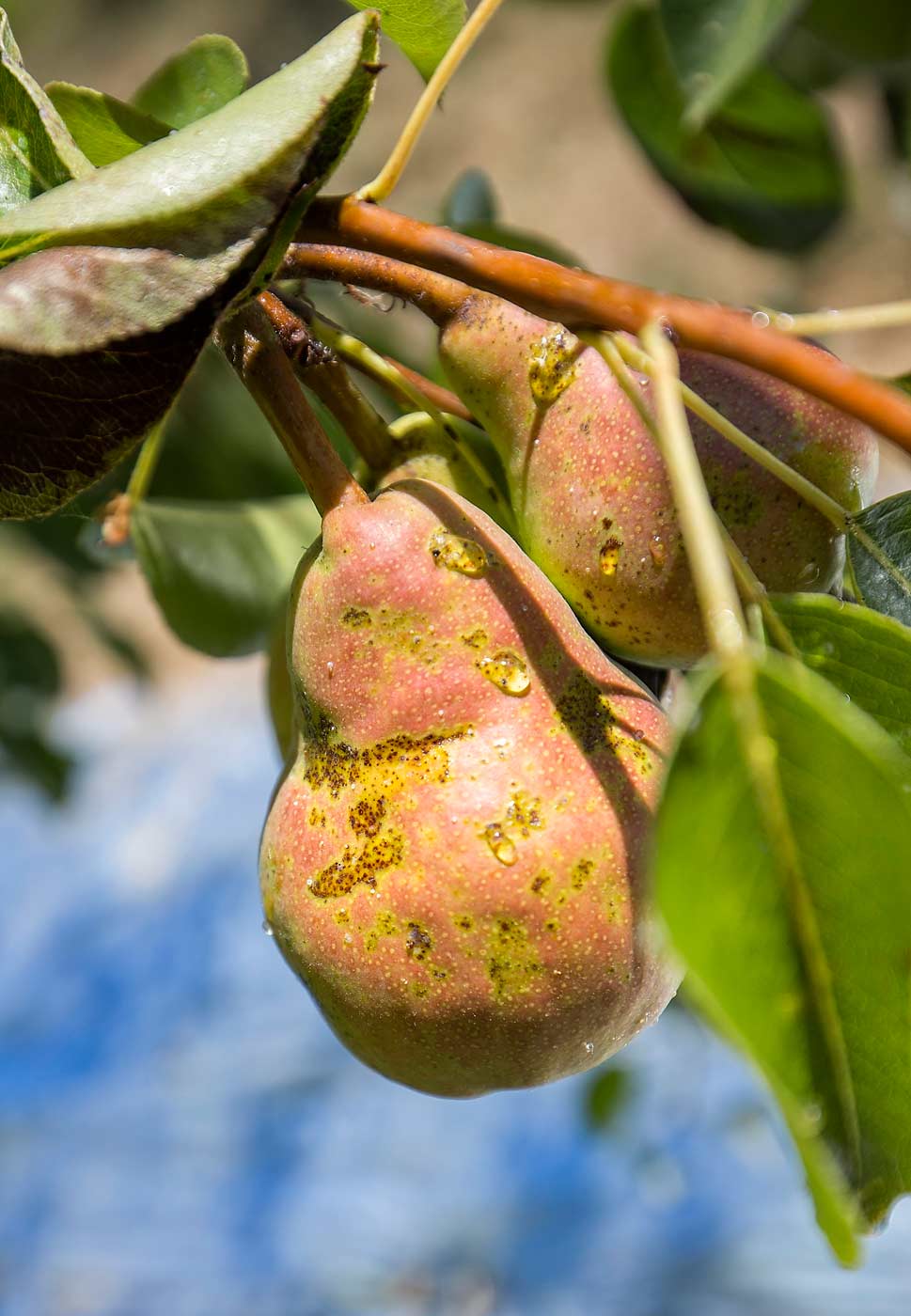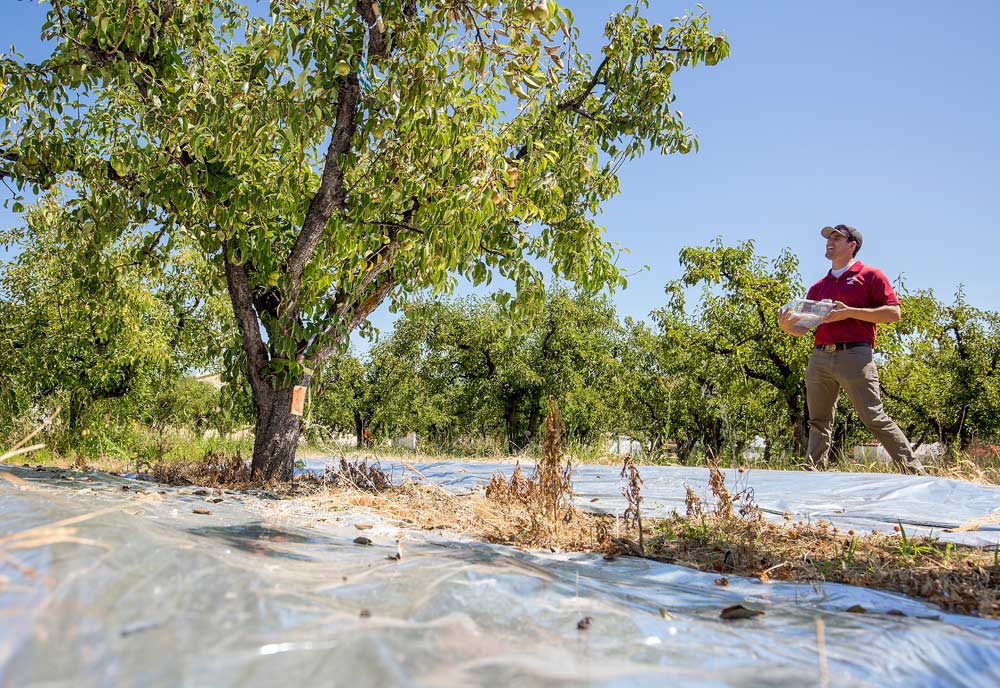
Washington State University researcher Louis Nottingham collects honeydew samples from Bartlett pear trees at the university test block in Wenatchee, Washington, on July 19, 2017. Nottingham is studying the effectiveness of reflective coverings to combat pear psylla. He says methods for collecting and measuring effectiveness has been part of the challenge, such as creating collection dishes that hang from trees. (TJ Mullinax/Good Fruit Grower)
Pear growers in Washington’s Wenatchee Valley face a sticky problem.
Pressure is mounting from pear psylla — which produce a sticky, fruit-damaging honeydew — and mites as the pests become increasingly resistant to the most commonly used insecticides.
But efforts to break that cycle are now underway by a team of Washington State University researchers who launched two pear IPM projects this year to study pesticide effectiveness, encourage the use of biocontrols and explore pest repellents.
Monitoring pesticide resistance is the easy part, said WSU entomologist Betsy Beers. “The harder question is what to do about it,” she said, of the new grower-driven research effort. “We knew we wanted to explore nonpesticidal tactics. The goal is to bring populations down enough so that the biological controls can keep up.”
Getting to that future involves understanding the natural enemies found in pear orchards and how best to design spray programs that protect them while remaining effective against psylla and mites.
To that end, WSU Extension tree fruit specialist Tianna DuPont is leading a survey of pest and predator populations in pear blocks across the valley, which she plans to use to develop guidance for growers on how to make selective spray decisions.
“Growers and fieldmen came to us and said, ‘We want to know what those (pest survey) numbers mean and what to do on a weekly basis,’” DuPont said. “We hope that we can come up with a set of thresholds or ratios that would be simple enough to use to collect the data and understand what type of spray would be most successful.”
Smarter chemical management

Bartlett pears show russetting from honeydew drips that are caused by pear psylla. (TJ Mullinax/Good Fruit Grower)
Today, many growers are spending upward of $1,000 an acre to control pear psylla and, in many cases, they are getting less control for their money.
Many are already moving away from broad-spectrum pesticides in favor of targeted or selective spray programs, but more research is needed to guide the best use of these products to maximize effectiveness and minimize off-target impacts.
All growers manage their spray programs a little differently, but for the purpose of the study, the researchers grouped orchards into conventional, soft or selective pesticide programs and organic.
“In the context of pears, it’s not going to be surprising to anyone that we are losing the efficacy of our pest control products,” DuPont said.
That’s why this project, which combines lab tests on pesticide efficacy and potential new controls with field surveys of pests and on-the-ground spray programs, is so important, she said.
It’s actually two projects: the more research-focused project run by Beers and funded with $353,709 for three years from the Washington Tree Fruit Research Commission and the extension side led by DuPont funded by $247,461 for three years from the Washington State Department of Agriculture.
Researchers introduced both efforts to growers at a Pear IPM field day in Cashmere, Washington, in June.
The Wenatchee Valley is particularly challenging for IPM because the valley is “wall to wall pears” with each orchard managed slightly differently, so you never get a population-level knock-out treatment, said Louie Nottingham, a postdoctoral researcher who joined WSU in January to work on pear pest research.
“We know that for something like pear psylla, which gets exposed to so many pesticides, resistance can develop very quickly,” he said.
That’s why he’s testing out the efficacy of more than a dozen pesticides on different psylla and mite life stages and looking for their impacts on natural enemies as well. Nottingham said he’s been surprised that most of the growers and field workers he works with are more interested in the natural enemies than the conventional chemicals.
“I thought the most important question for these guys would be which insecticides work best, but they really want to talk about natural enemies,” he said. “I think it’s because they know the pesticides are marginal at best for psylla.”
Pear psylla’s natural enemies include: deraeocoris, a small, common predator that feeds on psylla, spider mites and aphids; green lacewings; trechnites, a parasitoid wasp that lays its eggs in psylla nymphs; and campylomma, the bright green omnivore also known as mullein bug.
Surveys this season found large numbers of trechnites during bloom, DuPont said, in both organic and selectively managed orchards, as well as large numbers of campylomma in those blocks in June and early July.
Much work remains to collect and analyze data, but she expects the results to eventually give growers a better toolbox for using selective pesticides.
“We’re definitely seeing trends in differences between the conventional and selective programs,” DuPont said. “And we are also seeing natural enemies in conventional blocks, so that is good to see.”
Getting creative

Washington State University researcher Louie Nottingham is testing several types of reflective mulch to learn if it can reduce the incidence of pear psylla nymphs on pear trees. (TJ Mullinax/Good Fruit Grower)
The movement of pear psylla between orchards and native vegetation can make chemical control challenging, but it offers growers the chance to use repellents as well to knock down the pests.
“They move back into the orchards early in the spring in huge numbers. So ideally, we would like to knock them down outright early in the season, but it’s difficult to hit a flying target,” Nottingham said. Since they come into orchards over time, pesticides can miss, but repellents such as Surround, certain volatile chemicals or reflective mulch that increases light intensity could deter them.
“I’m not saying that we don’t want to kill them, because we do, but we’re looking for other tools,” Nottingham told growers at the pear IPM field day.
In a greenhouse study, he found that Surround, which coats leaves and prevents the insects from getting a grip, and oils of pine and cedar trees were the most effective at repelling adult psylla.
He also had promising results this spring with a trial using reflective mulch to shine more light into the canopy of Bartlett pears. It’s a technique that’s used by some citrus growers to control Asian citrus psylla.
Nottingham found about half as many psylla adults, nymphs and eggs in the trees with reflective mulch in the early season, compared to control. But that promising trend reversed itself as the season went on and pest counts spiked in the trees with the reflective mulch below.
It’s too early to say for sure, he said when Good Fruit Grower visited the trial in July, but Nottingham thinks the reflective foil is driving more vigorous canopy growth, and the psylla are then drawn to all the new shoots. In a commercial orchard where growers prune out those summer shoots, the outcome might be different, he said.
“I’m an entomologist, I’m not managing these trees like a commercial grower would,” he said. “In real life, there are ways to address this, such as taking out the mulch or trimming the suckers and shoots.”
Nottingham is also testing out some new methods to track psylla damage, in the form of the sticky honeydew that can cause russetting on the fruit and feed molds.
“As entomologists, I think we can focus too much on the populations and not the injuries, which is what matters most for pest control practices,” he said.
Lastly, he’s looking for growers to collaborate on experiments to see if washing off the honeydew — with overhead irrigation or a blast sprayer — reduces damage and increases the effectiveness of pesticide sprays.
Several growers at the field day offered their own anecdotal evidence to support the idea that washing trees would lower pest damage, although most pear growers have pulled out their old overhead irrigation in favor of drip to lower fire blight risks.
“Our overhead blocks are usually cleaner, but it depends on the growing conditions,” said Cashmere grower Loren Baird. “Like everything in farming.” •
– by Kate Prengaman






Leave A Comment